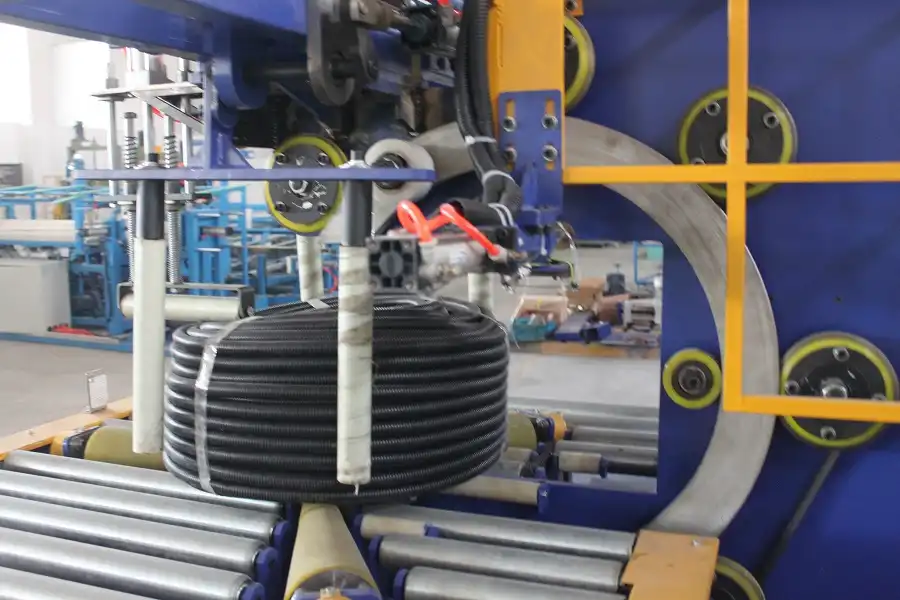A Fabricator's Guide to Automatic Hose Coiling and Wrapping Machines
Automatic hose coiling and wrapping machines are essential pieces of equipment in modern manufacturing and distribution environments dealing with flexible hoses and pipes. These automated systems streamline the process of taking long lengths of hose, coiling them into manageable sizes, and securely wrapping them for protection, handling, and storage. This guide explores the functionality, components, benefits, and considerations surrounding these machines.
Core Components and Functionality
An automatic hose coil making and wrapping machine integrates several key systems to perform its task efficiently:
Coiling Unit: This is the heart of the machine where the hose is wound into a coil. It typically features a motor-driven mandrel or roller system. Key aspects include:
- Variable Speed Control: Allows adjustment based on hose type and diameter.
- Tension Management: Ensures the hose is coiled tightly and consistently without damage.
- Adjustable Core: Accommodates different desired inner coil diameters and hose sizes.
Cutting Unit: Once the predetermined length of hose is coiled, the cutting unit activates.
- Precision Cutting: Provides a clean, square cut using blades or shear mechanisms.
- Programmable Length: Operators can set specific coil lengths via the control interface.
Wrapping Unit: After cutting, the finished coil is typically transferred or indexed to the wrapping station.
- Stretch Film Application: Applies layers of stretch film around the coil's circumference.
- Adjustable Overlap & Tension: Allows control over how securely the coil is wrapped, ensuring stability. Programmable overlap rates provide flexibility.
- Film Cut and Seal: Automatically cuts the film and secures the tail end.
Control Panel: The central interface for machine operation.
- Operator Interface (HMI): Allows programming of parameters like coil length, wrapping tension, overlap, and speed.
- PLC (Programmable Logic Controller): Manages the sequence of operations, timing, and integration of different components.
- Diagnostics and Monitoring: Provides status updates and error reporting.
Materials and Applications
These machines are versatile and can handle a wide variety of flexible products, including:
- PVC Hoses: Common in garden, irrigation, and industrial applications.
- PPR Pipes: Used in plumbing and water supply systems.
- HDPE Tubes: Employed in geothermal, water distribution, and conduit applications.
- Other Flexible Tubing: Can potentially be adapted for rubber hoses, PEX tubing, and similar materials depending on machine specifications.
The ability to customize coiling patterns and wrapping configurations makes these machines suitable for diverse packaging needs across industries like construction, agriculture, automotive, and general manufacturing.
Advantages of Automated Hose Coiling and Wrapping
Implementing an automatic system offers significant operational benefits:
- Increased Efficiency: Dramatically speeds up the coiling and wrapping process compared to manual methods.
- Consistent Quality: Produces uniform coils with consistent dimensions and secure wrapping, reducing product damage and improving presentation.
- Reduced Labor Costs: Frees up personnel from repetitive manual tasks, allowing them to focus on higher-value activities.
- Enhanced Safety: Automating the process reduces risks associated with manual handling and cutting of hoses. Features like safety guards and potentially double rubbing wheel devices enhance operational stability.
- Improved Logistics: Tightly wrapped coils are stable and well-protected, simplifying storage and enabling safe transportation. The wrapping provides a barrier against dust and moisture.

automatic hose coil packing machine3 Key Technical Considerations
When evaluating or operating these machines, several technical aspects are important:
- Adjustability: The machine must accommodate the range of hose diameters and lengths required. Features like an adjustable ring center height are crucial.
- Tension Control: Precise tension control for both coiling and wrapping materials is vital to prevent hose damage and ensure coil integrity.
- Operational Features: Functions like soft start/stop for smooth operation, automatic ring reset, and potentially integrated marking or tapping capabilities add value.
- Packaging Material: While stretch film is common, some systems might utilize other materials or methods depending on the application.
- Integration: Machines can be standalone units or integrated into a larger production or extrusion line.
Some specialized systems, like certain GS200 coil packaging models, are designed for broader applications, including the outer packing of metallic coils (copper, steel) or smaller diameter hose bundles, delivering stable, tidy, and protected packages. Various designs exist, including those suited for vertical coil packaging. For specific needs related to different coil types, exploring options like an automatic coiling machine might be relevant.
Conclusion
For businesses involved in the production or distribution of hoses and flexible pipes, automating the coiling and wrapping process offers compelling advantages in efficiency, consistency, cost savings, and product protection. Understanding the core components, capabilities, and benefits helps in selecting and utilizing this technology effectively. For businesses handling high volumes of hoses like PVC, PPR, or HDPE, investing in an Automatic Hose Coil Making and Wrapping Machine represents a strategic step towards optimized operations and improved product delivery.